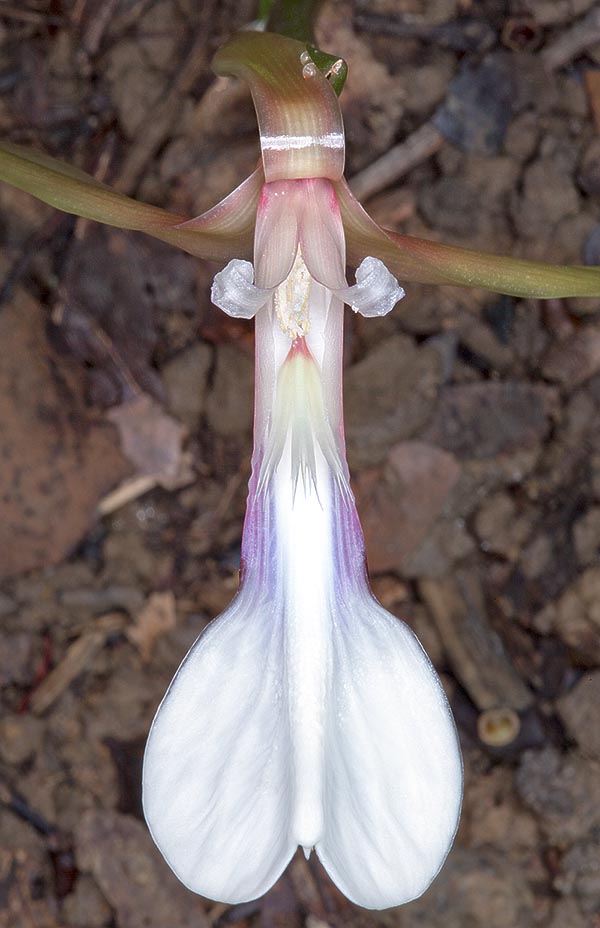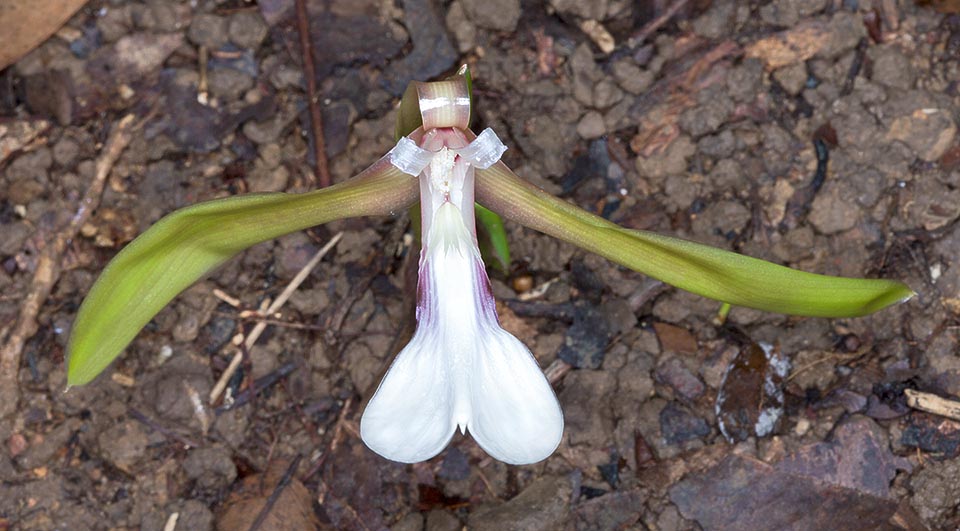Family : Lowiaceae

Text © Pietro Puccio

English translation by Mario Beltramini

Rarely cultivated, Orchidantha siamensis is a rhizomatous herbaceous species originating from the rainforests of Peninsular Malaysia, Singapore, and Peninsular Thailand © Giuseppe Mazza
The name of the genus comes from the combination of the Greek terms “ὄρχις” (orchis) and “ἄνθος” (anthos) = flower, hence ‘flower similar to an orchid’, the genus is in fact characterized by having the flowers with 3 sepals and 3 petals one of which very different in the shape, size and colour from the other two, structure reminding us that of the orchids; the specific name is the Latin adjective “siamensis” = of Siam (old name of Thailand), with reference to one of the places of origin.

Due to middle petal, 5-6 cm long, similar to a labellum, it reminds an orchid as the scientific name tells us © Giuseppe Mazza
Inflorescences at the base of the plant, persistent for long time, carrying bisexual flowers of short duration (1-2 days), that open in succession, with 3 sepals almost equal, 3 petals unequal and 5 stamens.
Linear-lanceolate sepals with pointed apex, 6-8 cm long and about 1 cm broad, retroflexed, of olive green colour with purple shades.
Thin lateral petals with toothed apex, retroflexed, 1,5-2 cm long and 2-3 mm broad, of white colour, median petal similar to the orchids labellum, 5-6 cm long and 2-2,2 cm broad at the apex, emarginate, of white colour.
Stamens, about 1 cm long, arranged in semicircle around the style and turned towards the labellum. Style, 1-1,5 cm long, with trilobed stigma, 1,5 cm long, with fringed lobes.
The fruit is a capsule with elongated apex, 2,5-3 cm long, containing numerous hairy seeds, 0,7 cm long, provided with aril. It reproduces by seed, but usually by division.
Species with ornamental foliage and flowers, of particular shape, produced for long time, rare in cultivation, might be advantageously utilized for borders or as ground cover in parks and shady gardens of the tropical and humid subtropical climate regions. It requires a semi-shaded to shaded position and loose soils, draining, rich of organic substance, maintained constantly humid.
Excellent subject to cultivate in pot for the decoration of winter gardens, verandahs and even little luminous inner spaces, with lowest winter temperatures not under the 16 °C and ambiental humidity 70-80%.
In order to increase the humidity in presence of high temperatures and dry air recourse may be done to frequent nebulizations with water at ambient temperature not calcareous, to avoid unaesthetic spots on the leaves. We can also create a humid microclimate around the plant placing it on an ample saucer filled up with expanded clay, or other inert material, with a layer of water not at direct contact with the bottom of the pot. The waterings must be regular and abundant in summer, more spaced in winter, but without ever allowing the substratum to dry up completely, and the fertilizations, during the vegetative period, done with a hydrosoluble product balance with microelements at half the dosage suggested on the package.

The inflorescences carry short-lived flowers that crop up from the soil, hidden among the leaves of the undergrowth, at the base of the plant © Giuseppe Mazza
→ To appreciate the biodiversity within the family LOWIACEAE please click here.
